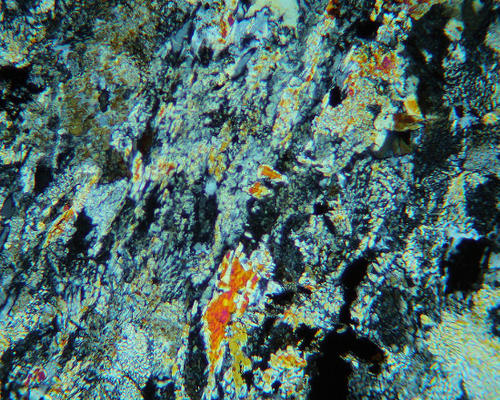Seismic rock properties at Earth’s plate boundaries
Thin-section of retrograde eclogite
Image Credit: Ringwoodit CC BY SA 4.0
Convergent Earth plate boundaries are among the most important places for the reorganisation of the Earth's crust and the recycling of elements. There, crustal material is transported to great depths, returned to the Earth's mantle, integrated into mountains and, in some cases, transported back to the surface (exhumed). All these processes lead to a change in the crustal rocks. However, this happens at depths that are inaccessible for direct observation. Therefore, such processes are studied either with geophysical imaging techniques (seismological surveys) or by examining exhumed rocks that have been metamorphosed and/or deformed in the past.
In order to interpret seismic velocities and infer metamorphic processes related to large-scale tectonics, it is still necessary to investigate how seismic properties change when rocks are altered by metamorphism or deformation.
The data
The data include 16 different 2D geometries used for modelling P-wave velocities and the corresponding P-wave anisotropy (directionality of wave velocities). The files are stored in the bitmap image file (bmp) file format and can be read in e.g. Matlab with the contour function.
Publication of the data set: Zertani S (2020) https://doi.org/10.17605/osf.io/y2e6v
Research results
Seismological studies of large-scale processes typically examine the Earth at a resolution of several kilometres, while field-based studies typically examine structures at a much smaller scale. To bridge this gap between scales, petrophysical properties at the 20-m, 100-m and kilometre scales were calculated using numerical models. In particular, the influence of eclogitisation processes at depth on seismological results was investigated, as the transformation of rocks into eclogite plays an important role in geodynamic processes.
The results of the publication directly link the partial conversion of rocks into eclogite to geophysical observations at active convergent plate boundaries. Furthermore, the results suggest that seismic anisotropy can be used as a tool to visualise the structural relationships at depth in order to identify the underlying mechanisms active during the ongoing eclogitisation of crustal rocks.
Publication of the journal article: Zertani S, Vrijmoed JC et al (2020) https://doi.org/10.1029/2019GC008906
Texts modified after: Zertani S, Vrijmoed JC et al (2020) https://doi.org/10.1016/j.qsa.2021.100022
